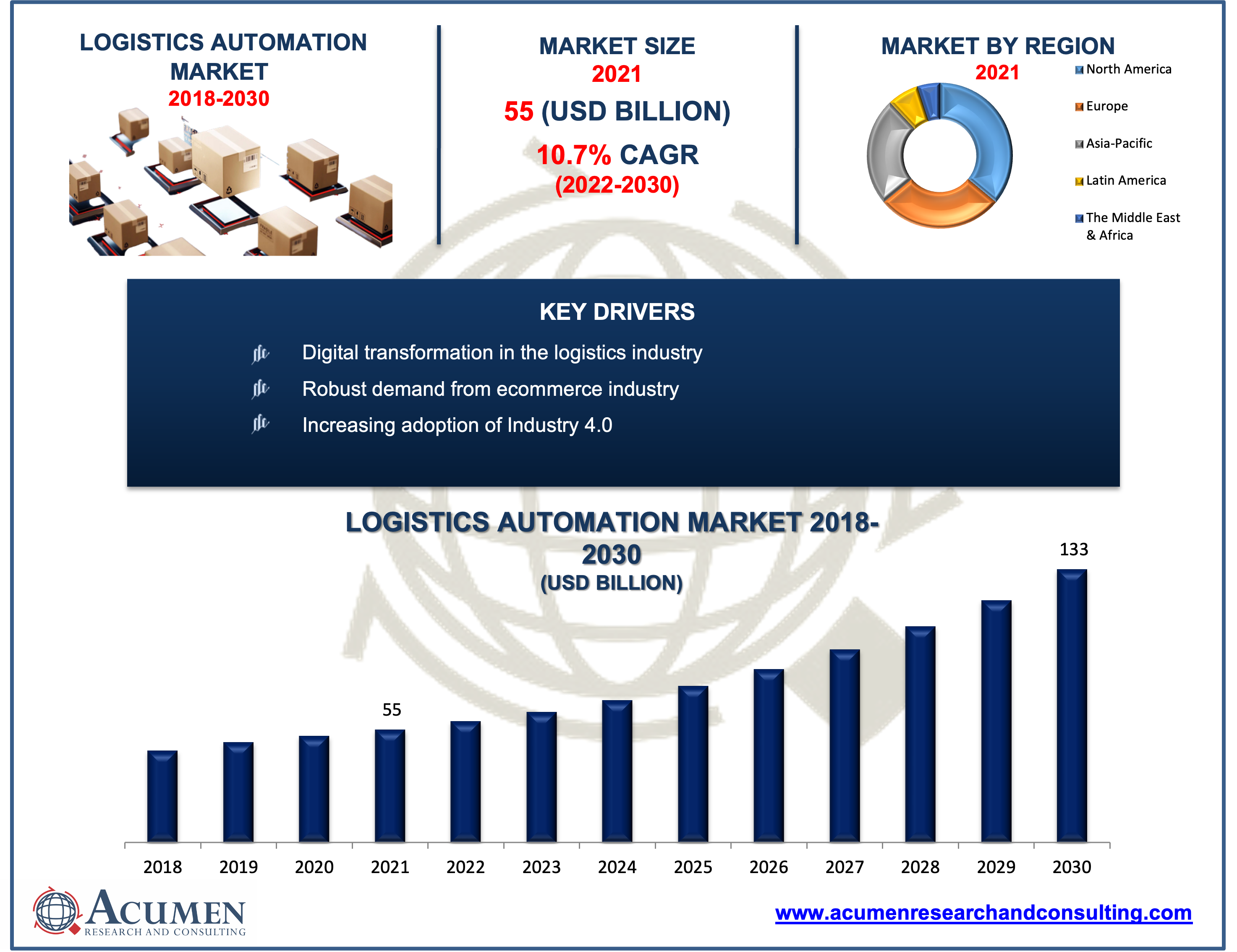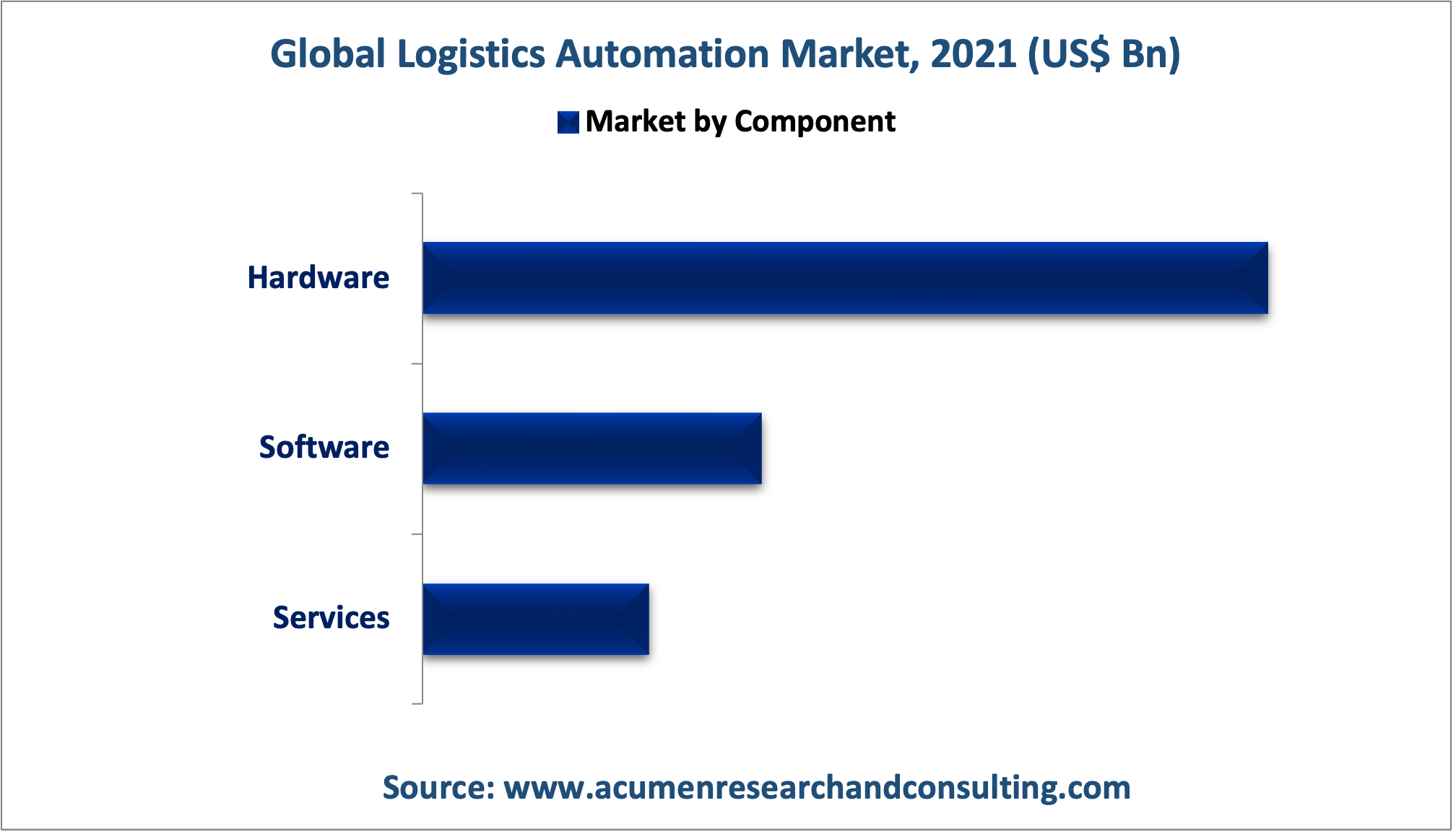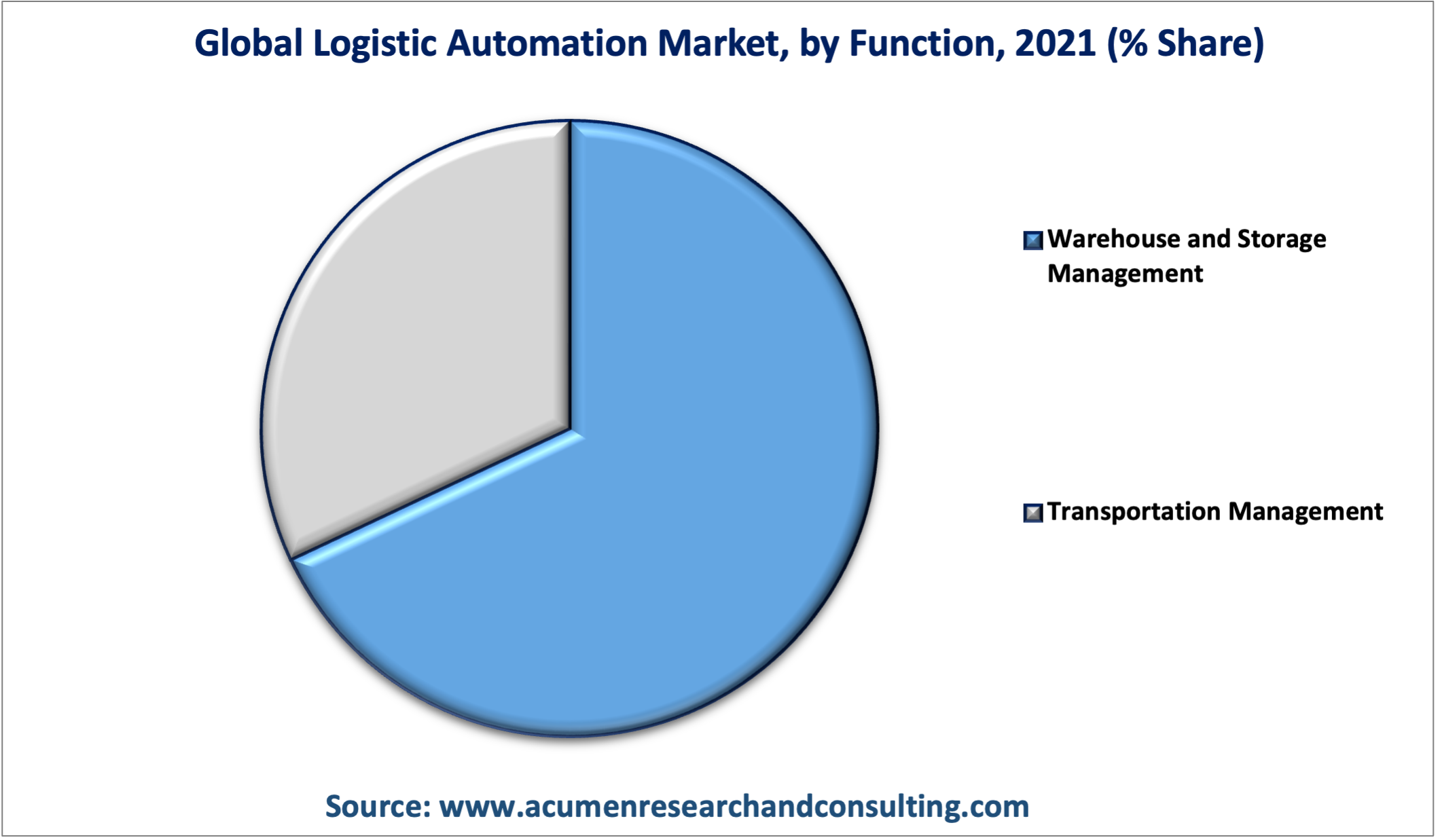Logistics Automation Market
Published :
Report ID:
Pages :
Format :
Logistics Automation Market
Report Coverage
- Industry Dynamics
- Market Size and Forecast Data
- Segment Analysis
- Competitive Landscape
- Regional Analysis with a Niche Focus on Country-Level Data
- High Level Analysis - Porter's, PESTEL, Value Chain, etc.
- Company Profiles of Key Players
- Option to Customize the Report As Per Your Specific Need
Request Sample Report
The Global Logistics Automation Market accounted for USD 55 Bn in 2021 and is estimated to reach USD 133 Bn by 2030, with a significant CAGR of 10.7% from 2022 to 2030.
Automation, often known as automatic control, is a term used in logistics to describe the use of control systems, gear, or software to improve operational efficiency. In a warehouse or distribution center, it generally refers to operations that require minimum amount of human intervention possible. Automation technologies such as intelligent document processing (IDP) systems, robotic process automation (RPA) bots, and full hyper-automation platforms that orchestrate end-to-end processes involving both software and human workers are helping logistics managers eliminate operation-wide inefficiencies. Logistics automation systems can be an excellent complement to the capabilities of higher-level computer systems. Although automated solutions may appear to be one-of-a-kind and complicated, the material flow is logical and methodically goes throughout the site.

Logistics Automation Market Growth Drivers
- Digital transformation in the logistics industry
- Robust demand from the eCommerce industry
- Advancements in robotics technology
Logistics Automation Market Restraints
- High capital investment
- Lack of standardization
Logistics Automation Market Opportunities
- Increasing adoption of industry 4.0
- Emergence of IoT
Logistics Automation Market Report Coverage
| Market | Logistics Automation Market |
| Logistics Automation Market Size 2021 | USD 55 Billion |
| Logistics Automation Market Forecast 2030 | USD 133 Billion |
| Logistics Automation Market CAGR During 2022 - 2030 | 10.7% |
| Logistics Automation Market Analysis Period | 2018 - 2030 |
| Logistics Automation Market Base Year | 2021 |
| Logistics Automation Market Forecast Data | 2022 - 2030 |
| Segments Covered | By Component, By Function, By Organization Size, By Industry Vertical, And By Geography |
| Logistics Automation Market Regional Scope | North America, Europe, Asia Pacific, Latin America, and Middle East & Africa |
| Key Companies Profiled | Daifuku Co., Ltd, Dematic Corp, Honeywell Intelligrated, Inc., Knapp AG, Jungheinrich AG, Mecalux, S.A., Murata Machinery, Ltd, SSI Schaefer LLC, Swisslog Logistics, Inc., Toshiba Logistics Corporation, and Vitronic Machine Vision, Ltd. |
| Report Coverage |
Market Trends, Drivers, Restraints, Competitive Analysis, Player Profiling, Regulation Analysis |
Logistics Automation Market Dynamics
Logistics automation is primarily supported by the ongoing digital transformation in the industry. In transportation & logistics, efficiency, optimization, speed, and timing have always been critical. The process of applying and integrating information, computing, communication, and connectivity technologies into logistics and transportation activities, from inventory management to information storage to transportation and distribution, is known as digital transformation in logistics.
However, the high capital investment in the technology would hamper the market from growing. Using machines, robots, artificial intelligence, and so on necessitates a significant investment. Not only that, but the use of digital transformation in the supply chain revealed a significant amount of wasted software, amounting to up to 37% of total spending. Such high capital investments are creating a roadblock for small-scale warehouse owners to integrate automation in their logistics business, thereby limiting the market growth. On the other hand, the emergence of IoT and the integration of AI are expected to ease the automation process in any logistic facility. For instance, with the introduction of artificial intelligence (AI) and the Internet of Things (IoT), logistics automation tools began to face more complex problems. Today, AI and IoT-enabled automation tools are automating logistics tasks ranging from document verification to order tracking to predictive modeling.
Furthermore, factors such as advancements in the robotics industry and the rising adoption of industry 4.0 are likely to generate numerous growth opportunities for the market in the coming years. Logistics robots automate the storage and movement of goods as they move through the supply chain. They're frequently used to organize and transport products in warehouses and storage facilities, a process known as intralogistics.
Logistics Automation Market Segmentation
Component, function, organization size, industry vertical, and region are all used to segment the worldwide logistics automation market
Logistics Automation Market By Component
- Hardware
- Software
- Services

Based on components, the hardware segment gathered a significant amount of market share in 2021. The hardware segment consists of mobile devices, fixed machinery, sorting and picking systems, industrial robots, automated guided vehicles, and so on. The high cost of these hardware components has supported the substantial revenue of the segment. Hardware components of logistic automation are used to handle critical operations. Moreover, mobile computers and tablets, smartphones, and sensors that are essential devices can reduce safety risks, accelerate employee training, and improve human-machine communication.
Logistics Automation Market By Function
- Warehouse and Storage Management
- Transportation Management

Warehouse and storage management and transportation management are two very crucial functions of any warehouse or distribution center (DC). A warehouse and storage management system (WMS) is a collection of software and processes that enable businesses to control and manage warehouse operations from the time goods or materials enter the warehouse until they leave. On the other hand, the transportation management system (TMS) assists shippers in locating the best carriers and shipping lanes for their products, as well as tracking shipments throughout the supply chain.
Logistics Automation Market By Organization Size
- Large Enterprises
- SMEs
Logistics automation in large enterprises is used to a greater extent because they have thousands or millions of products to deliver in a day. Due to the growth in the e-commerce industry, e-commerce and warehouse giants cannot satisfy customers’ on-demand deliveries only based on the human workforce. Thus, large enterprises have shifted their focus towards logistics automation which offers them increasing speed of product delivery, reduced cost of last-mile delivery, fewer errors, and better management of their storage and transportation. Amazon, FedEx, Nike, Walmarts, and IKEA, for example, have already automated their warehouses in many parts of the world. However, with the given benefits of automation in the logistics industry, SMEs are also expected to automate their processes very soon.
Logistics Automation Market By Industry Vertical
- 3PL
- Aerospace and Defense
- Chemicals
- Fast-Moving Consumer Goods (FMCG)
- Healthcare and Pharmaceuticals
- Manufacturing
- Oil, Gas, and Energy
- Retail and eCommerce
- Others (paper and printing, and textiles and clothing)
Retail and eCommerce is one of the leading industries that require logistics automation owing to their storage, handling, and transportation processes. E-commerce has fundamentally altered the retail supply chain. Orders must be delivered quickly and accurately in order to ensure customer satisfaction and profit. Logistics automation's flexible and modular technologies and software are designed to meet the changing needs of retail, e-commerce, and multichannel logistics.
Logistics Automation Market Regional Overview
North America
- U.S.
- Canada
Europe
- U.K.
- Germany
- France
- Spain
- Rest of Europe
Latin America
- Mexico
- Brazil
- Rest of Latin America
Asia-Pacific
- India
- Japan
- China
- Australia
- South Korea
- Rest of Asia-Pacific
The Middle East & Africa (MEA)
- Gulf Cooperation Council (GCC)
- South Africa
- Rest of the Middle East & Africa
The early adoption of automation technologies fuels the North America market growth
Based on the regional segmentation, the North American region generated the maximum revenue in 2021. This is credited to the presence of a large number of retails, eCommerce, transportation, automotive, industrial, healthcare and pharma industries. However, the Asia-Pacific region is anticipated to attain the fastest growth rate during the forecast period due to the rapid adoption of new technologies, growth in online sales, and the expansion of logistics and transportation industries.
Logistics Automation Market Competitive Landscape
Some of the top vendors offered in the professional report include Daifuku Co., Ltd, Dematic Corp, Honeywell Intelligrated, Inc., Knapp AG, Jungheinrich AG, Mecalux, S.A., Murata Machinery, Ltd, SSI Schaefer LLC, Swisslog Logistics, Inc., Toshiba Logistics Corporation, and Vitronic Machine Vision, Ltd.
Frequently Asked Questions
How much was the estimated value of the global logistics automation market in 2021?
The estimated value of global logistics automation market in 2021 was accounted to be US$ 55 Bn.
What will be the projected CAGR for global logistics automation market during forecast period of 2022 to 2030?
The projected CAGR of Logistics Automation market during the analysis period of 2022 to 2030 is 10.7%.
Which are the prominent competitors operating in the market?
The prominent players of the global logistics automation market involve Knapp AG, Mecalux, S.A., Dematic Corp, Daifuku Co., Ltd, Jungheinrich AG, SSI Schaefer LLC, Swisslog Logistics, Inc., Murata Machinery, Ltd, Honeywell Intelligrated, Inc., Vitronic Machine Vision, Ltd., and Toshiba Logistics Corporation.
Which region held the dominating position in the global logistics automation market?
North America held the dominating share for logistics automation during the analysis period of 2022 to 2030.
Which region exhibited the fastest growing CAGR for the forecast period of 2022 to 2030?
Asia-Pacific region exhibited fastest growing CAGR for logistics automation during the analysis period of 2022 to 2030.
What are the current trends and dynamics in the global logistics automation market?
Digital transformation in the logistics industry, robust demand from the ecommerce industry, and increasing adoption of industry 4.0 drives the growth of global logistics automation market.
By segment component, which sub-segment held the maximum share?
Based on component, hardware segment held the maximum share for logistics automation market in 2021.


